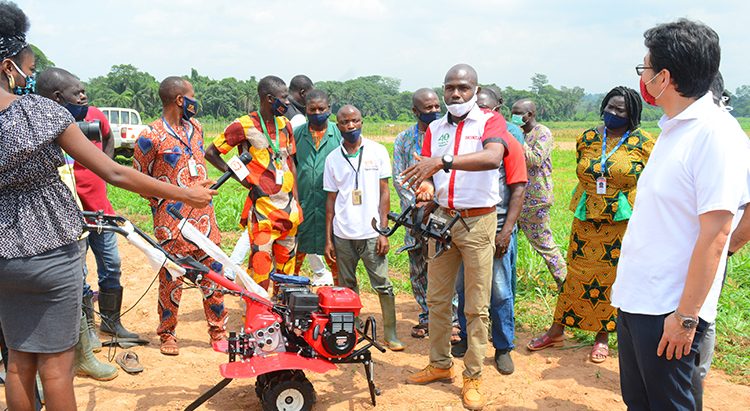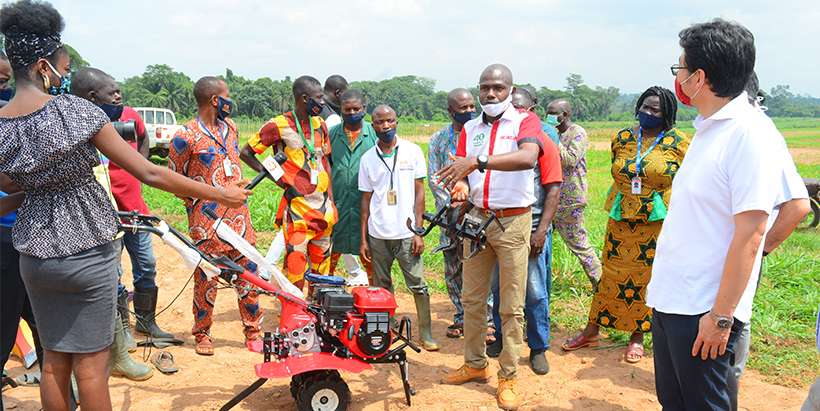
A machine for making yam mounds?
Yam is the “king of crops” in West Africa and one of the most important energy sources for many African countries. However, cultivating and preparing it is tedious for farmers because yam is planted in mounds (30 to 50 cm high and 1 or 2 m apart).
The advantage of the mound system in yam production includes loose soil conditions for easy tuber penetration, the collection of fertile topsoil, water control, and ease of harvesting. In addition, loose soil holds plenty of water and produces well-shaped yam tubers.
Making mounds is tough and particularly labor-intensive in yam cultivation and is one of the difficulties in expanding yam production and reducing costs in West Africa. Other challenges are low seed technology and pest and disease problems. IITA scientists Ryo Matsumoto and Haruki Ishikawa are working on mechanizing land preparation and making yam mounds using a small tiller in collaboration with private sector partner Honda under a project supported by the Ministry of Agriculture, Forestry and Fishery (MAFF) Japan. The simple protocol for land preparation and making mounds using a small tiller (FJ-500 with a New Yellow Ridger) was developed through collaborative activities. The steps include:
- Plowing well with a small tiller to soften the soil.
- Using the cross-ridging technique (vertical and horizontal cross ridging).
- Making mounds using a hoe.
Using this protocol took two and a half hours from plowing to making 144 mounds with four people, spending less than 200 mL of fuel to prepare an area of 13 m × 13 m.
The staff who tried this protocol said: “The most significant advantage of this process is that the soil becomes very soft. After land preparation with the small tiller, it is very easy to make mounds.”
Ishikawa, the MAFF project leader, said: “When Honda and I discussed yam production, I said it is very difficult (or impossible) to make yam mounds with a machine. Honda disliked the word ‘impossible’ and saw a good opportunity to come up with a solution. However, the technique still needs improvement because part of the process is manual.”
Matsumoto said, “This is an entry point for mechanized yam cultivation. I hope that this protocol can help yam farmers in Nigeria. The small tiller can help in land preparation for yam and can be applied for yam seed tuber production.”
To move the collaboration forward, a team from Honda Manufacturing Nigeria visited IITA on 18 June to exchange views with IITA researchers Matsumoto and Ishikawa on utilizing small tillers in small-scale farmers. In addition, the Institute signed a Memorandum of understanding (MOU) with Honda Manufacturing Nigeria Ltd for the small tiller. Under this MoU, a new model
of Honda small tiller in Nigeria, FQ650, which has higher power than the FJ-500, was introduced to IITA. It will be used for research and demonstration activities in IITA for the next two years. Furthermore, the collaborators have committed to continuing yam mechanization to reduce the hard work involved.
The process—from plowing to yam mound making—is documented in the “Yam Mounds Making Machine” (https://www.youtube.com/watch?v=Mol_ugUgbHk) and “Honda FQ650 Furrow attachment” (https://www.youtube.com/watch?v=bdgbNHLhQwg) videos.
If you are interested in a small tiller and attachment, contact Honda Manufacturing Nigeria Ltd (sales.hondamanufacturingnigltd@honda-eu.com). For technical issues on land preparation for yam with the small tiller, contact Ryo Matsumoto (r.matsumoto@agiar.org).

